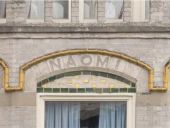The two distinctly different buildings in the picture symbolize the history and diverse make-up of the Transvaal neighborhood in Leiden. This neighborhood has always been characterized by the variation in houses and residents. Along De Rijn there have been three estates since the 17th century: Oranjelust, Bloemlust and Rhijnzicht. Living along De Rijn at that time was marked by industry and labor-intensive work: think of the cloth houses for textile workers, construction sites and the production of other building materials. In a different area, rich residents had ‘playgrounds’ for relaxation and entertainment, and there were many vegetable and fruit farmers.
In the 19th century, more and more houses appeared on the waterfront and on the inside of the Morsweg (between the road and De Rijn).P.J.M. de Baar, 1988. Wonen aan het Galgenwater. The city villa in the picture stands on the outer edge of the parcel of the old estate called Oranjelust (between Morsweg 22 and 46), which was there until around 1900 (fig. 1). After the estate was taken down, the land was divided into lots. The city villa was the first building to arise on the former Oranjelust estate. The owner gave the villa the biblical name Naomi, which in Hebrew means ‘my dear’ (fig. 2).
When the house was first built, it was still surrounded by greenery, but this would soon change.Stadsarchief van Leiden 1816-1929, Erfgoed Leiden en Omstreken.
At the beginning of the 20th century, the Transvaal neighborhood included a number of large factories. Little worker houses were built on the other side of the Morsweg to house factory employees.The stories on the Wolmaranstraat and the Transvaalhof tell a lot about the workers houses in Transvaal.
With the expansion of the university in Leiden, the Transvaal neighborhood also started to house students. For example, in the 19th century, the Rhijnzicht estate, which had already been transformed into a swimming facility, was replaced by a boat house for the oldest students rowing association, Njord.Read the following stories if you want to know more about Njord. But it was only after World War II that students started inhabiting the neighborhood on a larger scale. Because of the democratization of higher education and the increase in social security, Dutch universities grew exponentially in the second half of the 21st century. Students started to become more visible in the streets of the Transvaal neighborhood. Not only the number of students increased, but housing to accommodate them popped up everywhere in the neighborhood as well.
](https://micrio.thingsthattalk.net/ERuja/views/max/174x128.s.jpg)
